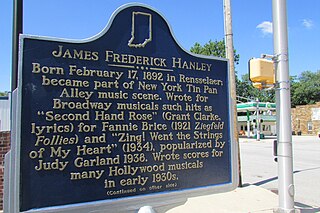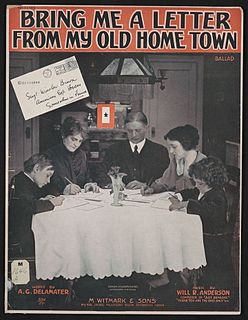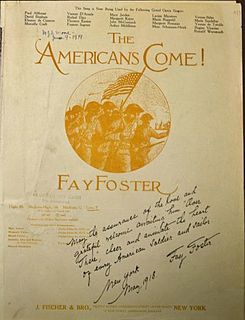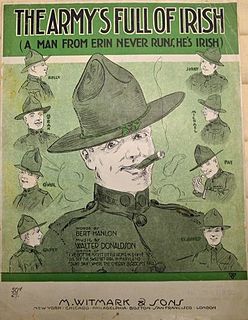
Jean Schwartz was a Hungarian-born American songwriter.
Fred Fisher was a German-born American songwriter and Tin Pan Alley music publisher.
Ballard MacDonald was an American lyricist, who was one of the writers of Tin Pan Alley.

James Frederick "Jimmy" Hanley was an American songwriter and author.

"Bring Me a Letter from My Old Home Town" is a World War I era ballad song released in 1918. A.G. Delamater wrote the lyrics and Will R. Anderson composed the music. It was written for both voice and piano.

"I'm Goin' To Fight My Way Right Back to Carolina" is a World War I era song written and composed by Billy Baskette and Jessie Spiess. The song was published in 1918 by McCarthy & Fisher, Inc. of New York, New York. The sheet music cover was designed by Andre C. De Takacs. It features an armed soldier tearing through the cover. The song was written for both voice and piano.

"The Dream of a Soldier Boy" is a World War I song written by Al Dubin and composed by James V. Monaco. It was published in 1917 by Witmark & Sons in New York City. The sheet music cover depicts a photo of a soldier embracing his mother while a proud father and others look on.
"Lafayette " is a World War I song written and composed by Mary Earl, which was a pseudonym of Robert A. King. It was published in New York, New York by Shapiro, Bernstein, & Co. in 1918. The sheet music cover, illustrated by Albert Barbelle, depicts soldiers marching with fixed bayonets below a statue of Lafayette in silhouette.

"I'm Crazy Over Every Girl In France" is a World War I song written by Alfred Bryan and composed by Pete Wendling and Jack Wells. The song was published in 1917 by Waterson, Berlin, & Snyder Co., in New York, NY. The sheet music cover, illustrated by Barbelle, depicts a soldier standing against a sea wall with a woman on top of the wall, her arm on his shoulder watching another girl walking by and features battleships in the background.

"America's the Word for You and Me" is a World War I song written composed by Jacob J. Tanner Jr. The song was published in 1918 by Jacob J. Tanner Jr., in Pittsburgh, Pennsylvania. The sheet music cover depicts a photo of President Wilson and the head of Uncle Sam with an inset of George Washington.
"It Won't Be Long Before We're Home" is a World War I song in the style of a march. It was written by Paul Cunningham and composed by Joseph E. Howard. This song was published in 1918 by M. Witmark & Sons, in New York, NY.

"Mother, Here's Your Boy!" is a World War I song written and composed by Sidney D. Mitchell, Archie Gottler, and Theodore Morse. This song was published in 1918 by Leo. Feist, Inc., in New York, NY. The sheet music cover depicts Uncle Sam presenting a returning soldier to his mother with the Statue of Liberty and ships in the background.
"Give a Little Credit to the Navy" is a World War I song written by Buddy DeSylva & Gus Kahn and composed by Albert Gumble. This song was published in 1918 by Jerome H. Remick & Co., in Detroit, MI.
We Want Our Daddy Dear, Back Home is a World War I song written by James M. Reilly and composed by Harry DeCosta. The song was first published in 1918 by M. Witmark & Sons in New York, NY. The sheet music cover features a vitagraph photo of Aida Norton and a seated child.
Wee Wee Marie is a World War I song written by Alfred Bryan & Joe McCarthy and composed by Fred Fisher. The song was first published in 1918 by McCarthy & Fisher, Inc., in New York, NY. The sheet music cover depicts a soldier and a woman facing each other speaking.

"The Americans Come " is a World War I song written and composed by Fay Foster. The song was first published in 1918 by J. Fischer & Bro., in New York City. The sheet music cover depicts soldiers marching with a city and battleship on the left and a bombed city on the right.
There's A Picture In My Old Kit Bag is a World War I song written and composed by Al Sweet. This song was first published in 1918 by Ted Browne Music Co., in Chicago IL..The sheet music cover depicts a soldier in a trench looking at a picture.
Three wonderful Letters From Home is a World War I song written by Ballard MacDonald & Joe Goodwin and composed by James F. Hanley. The song was first published in 1918 by Shapiro, Bernstein & Co., in New York, NY. The sheet music cover depicts a mother, wife, and daughter writing letters with marching troops and a plane, ship, and tank in the background.

The Army's Full Of Irish is a World War I song written by Bert Hanlon and composed by Walter Donaldson. The song was first published in 1917 by Witmark & Sons in New York, NY. The sheet music cover depicts a soldier smoking a cigar flanked by eight soldiers with Irish names.
When the Flowers Bloom On No-Man's Land is a World War I song written by Howard E. Rogers and composed by Archie Gottler. The song was first published in 1918 by Kalmar, Puck, & Abrahams Music Co., in New York, NY. The sheet music cover depicts soldiers marching with an inset photo of Fred Weber. The sheet music was later reprinted with an inset photo of Dorothy Jarrett.










